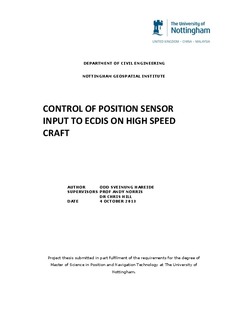| dc.description.abstract | By 2018 all larger ships are to be equipped with Electronic Chart Display and Information System (ECDIS). The paradigm shift from paper charts to electronic charts has been a technological leap for mariners, and the Integrated Navigation Systems (INS) are getting more and more complex. This leads to new challenges for the navigators of today.
Global Navigation Satellite Systems (GNSS) such as GPS are the primary position sensor input for ECDIS, and it has since its early beginning in the middle of the 1990s been very reliable. National and worldwide statistics show that there has been a slight increase in navigational accidents since the introduction of ECDIS, but the reasons for this is not clear. In the literature review it is laid down that position sensors have its potential fault, and GNSS and its augmentation systems is described to better understand its advantageous and limitations. Control of ECDIS with position control methods are explored, and divided into two methods of control: Visual- and Conventional methods.
Through field work, simulator tests and interviews the findings are clear. The navigators of today rely too much upon their primary position sensor which normally is a GNSS such as GPS. A questionnaire reveals that the navigators have insufficient deeper system knowledge of the navigation aids in use. This can lead to a potentially serious accident with loss of lives and large environmental damage. To achieve safe navigation it is important to continuously conduct control of primary position sensor input to ECDIS with a secondary position sensor by visual- and/or conventional control methods. The advantages and limitations with the different methods of control are discussed. Position sensors such as GNSS can fail, and navigators of today and tomorrow need to monitor the position sensor input to ECDIS with other means than GNSS. | nb_NO |
